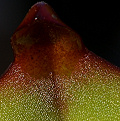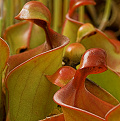Q: Heliamphora cultivation
A: To first approximation, general cultivation of Heliamphora
is much like growing highland Nepenthes. They do well in large pots with Sphagnum-rich
mixes, they should be top-watered instead of watered by trays, do not expect a significant yearly variation in temperatures,
and may or may not appreciate fertilizing (this depends upon the skill of the
applicator and fertilizer selected). However---and here is the tricky part---in terms of the temperature ranges and sunlight intensity
they are more like Darlingtonia.
There is no doubt about it. Maintaining a very bright, humid, but cool environment is not easy, and that is why most growers are
unsuccessful with their Heliamphora. On the other hand, for growers who can achieve such conditions,
Heliamphora is a veritable unkillable beast.
Plants in inadequate light do not produce the leaf morphology characteristic of their
species.
To be successful, you should target 16-27°C (60-80°F), although mine have experienced peak temperatures of
41°C (105°F) and still flowered. I prefer a potting mix of pure live or long fiber Sphagnum,
but I have also had luck with 2:1 Sphagnum:perlite, and also 2:1:1 mix of
perlite:peat:sand.
I readily admit that I grow my plants poorly because I am not interested in the gymnastics required to grow them cool enough. As such,
my plants are weak and prone to damage and slow growth. One symptom of this unhappiness is that the plants really dislike
repotting---many times I have repotted a large plant just to have it respond by dying. Growers like Peter D'Amato who have better
temperatures do not have problems with repotting.
If you are a first-time grower, I suggest you start with a hybrid. Also, I find that both H. minor
and H. nutans are relatively forgiving (at least for the clones I grow). If you obtain plants from
tissue culture, do not grow overly confident if you do well with your plants---Heliamphora
fresh from tissue culture show unnatural vitality for about a year. After a while they slow in growth, and behave more
naturally.
Well-grown Heliamphora flower readily, but they must be pollinated manually.
Encouraging a flower to produce pollen is
difficult. Don Schnell obtained pollen when his flowers were resting against
the hot glass just under fluorescent lights. Why this works for a
plant which lives on the rainy tepuis is a mystery to me. A more widely used
practice is to use a tuning fork to rattle the pollen from the anthers.
Some people grow these plants very well. I am quite adept at keeping them
miserable and pathetic. They just barely limp along under my "care". They annoy me for this reason. I
encourage you to review D'Amato's books. He and his staff at California Carnivores are vastly more successful than myself!
Page citations: D'Amato, P. 1998, 2013; Dodd, C., and Powell, C. 1988; Rice, B. 2006a;
Schnell, D.E. 1982.

